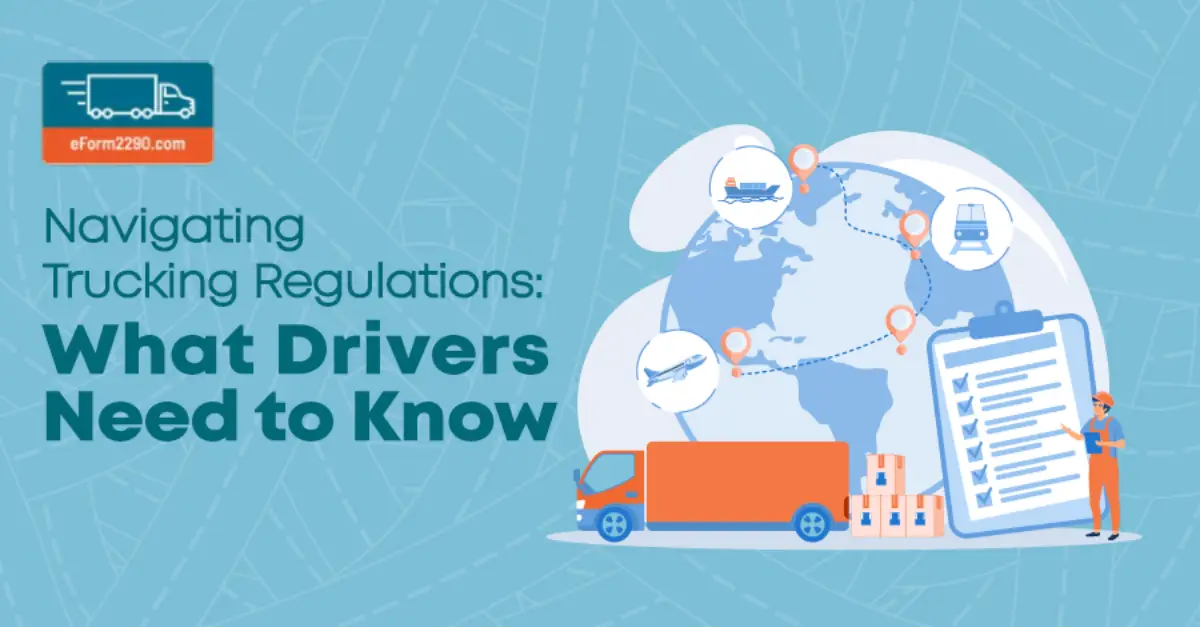Navigating Trucking Regulations: What Drivers Need to Know

- As a trucker or fleet operator in the United States, understanding trucking regulations can be very helpful for your journey on the road. In this blog, we will discuss the details of the trucking regulations that every trucking professional should be aware of. From the Hours of Service to Hazardous Materials Transportation, we'll break down the key aspects of these rules, providing you with the knowledge you need to navigate the roads with confidence.
The Crux of Trucking Regulations: Safety and Order
Before we dive into the specifics, let's establish why these regulations matter. At their core, trucking regulations are designed to achieve two paramount goals: safety and order on the nation's roadways. They aim to prevent accidents, protect drivers and the public, and maintain the integrity of the transportation industry.
Now, let's explore these essential trucking regulations in detail:
1. Hours of Service (HOS)
HOS regulations dictate how long a driver can be on the road before taking mandatory rest breaks. These rules are crucial in combating driver fatigue, a leading cause of accidents. As a truck driver, understanding HOS limits and scheduling your journeys accordingly is not just a matter of compliance but also for your own personal safety.
According to the Federal Motor Carrier Safety Administration (FMCSA), in 2019, 5,237 large trucks and buses were involved in fatal crashes. Fatigue-related accidents remain a significant concern. This helps us understand why HOS is important for truckers.


2. Weight Limits
Weight limits are in place to protect the structural integrity of roads and bridges. Overloaded trucks can cause extensive damage to infrastructure and pose serious safety hazards. Familiarizing yourself with weight limits can help make sure you stay compliant and also be a responsible trucker who helps in maintaining the roads.
To know more about the guidelines on weight limits and regulations you can also visit the American Association of State Highway and Transportation Officials (AASHTO) website.
3. Vehicle Inspections
The Commercial Vehicle Safety Alliance (CVSA) conducts the International Roadcheck each year. In 2020, over 50,000 inspections were performed, resulting in 12,000 vehicles being placed out of service. This is a reason why routine vehicle inspections are important to make sure your truck is in top-notch condition. Both pre-trip and post-trip inspections are required by law to identify and rectify potential issues promptly.
4. Commercial Driver License (CDL)
Your CDL is your ticket to the road, and obtaining and maintaining it is a multi-step process that involves training, testing, and adhering to specific regulations. Keeping your CDL up to date is non-negotiable.
5. Drug and Alcohol Testing
A drug and alcohol testing program is mandated for all trucking professionals. The objective is to make sure that drivers are not impaired while operating a commercial vehicle, guaranteeing safety for everyone on the road. The Substance Abuse and Mental Health Services Administration (SAMHSA) sets the standards for drug testing in the transportation industry.
6. Registration and Licensing
Proper registration and licensing of your commercial vehicle is essential. Different states may have specific trucking regulations, and staying compliant with these regulations is vital to avoid fines and roadblocks to your work.
7. Electronic Logging Devices (ELDs)
ELDs have replaced paper logs in tracking a driver's hours of service. They ensure accuracy and help prevent violations, promoting safer and more efficient operations.


8. Speed Limits and Traffic Laws
While speed limits and traffic laws may seem obvious, they are often overlooked. Staying within speed limits and obeying traffic laws not only keeps you compliant but also significantly reduces the risk of accidents.
Speeding was a contributing factor in 26% of all traffic fatalities in 2019, according to the National Highway Traffic Safety Administration (NHTSA). Thus, remember to adhere to speed limits and traffic laws. This helps you stay safe while you are out on the road.
9. Weight Stations and Scales
The Federal Highway Administration (FHWA) provides guidelines on weight station operations. Weight stations and scales are strategically placed to monitor and enforce weight limits. Failing to stop at these stations can lead to non-compliance with trucking regulations and attract hefty fines and disruptions to your journey.
10. Hazardous Materials Transportation
According to the Pipeline and Hazardous Materials Safety Administration (PHMSA), over 1.2 million shipments of hazardous materials are transported daily in the U.S. Transporting hazardous materials requires specialized training and adherence to strict regulations. These regulations exist to prevent accidents and protect both the environment and public safety.
11. Rest Breaks
Rest breaks, although closely related to Hours of Service HOS, deserve a special mention. Rest breaks, although closely related to HOS, deserve a special mention. Taking frequent rest breaks is important to ensure your safety. Adequate rest breaks are not just a regulation; they are a practice that can save lives.
The trucking regulations may seem daunting, but these rules are not meant to hinder your journey but to make it safer, more efficient, and more professional. We hope you've found this blog helpful in understanding the trucking regulations that shape your industry.
Remember, compliance is not just a legal requirement; it's a commitment to the safety of yourself and others on the road. Stay informed, stay safe, and stay on the right side of the road. For more updates and valuable insights on trucking regulations and industry trends, be sure to follow us on our social media handles.

